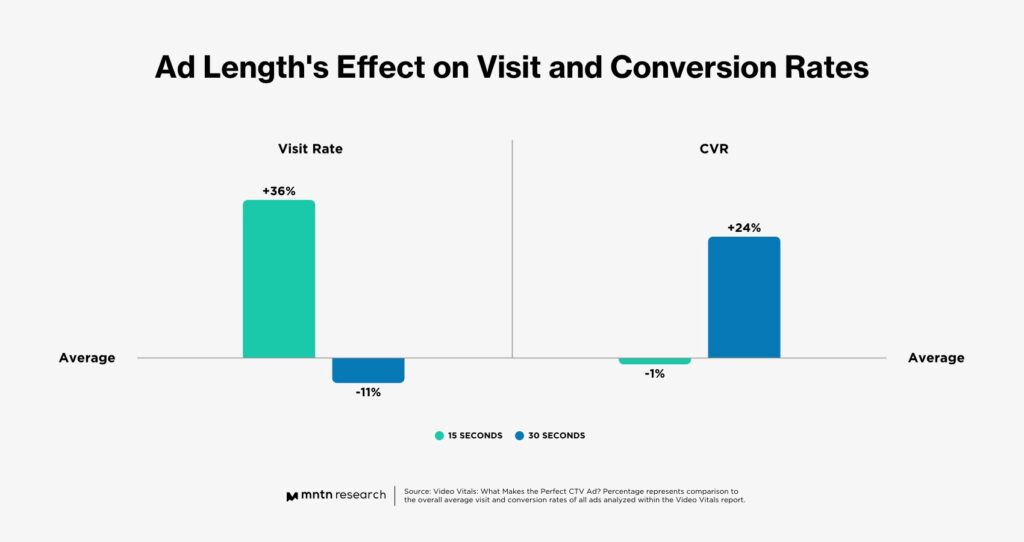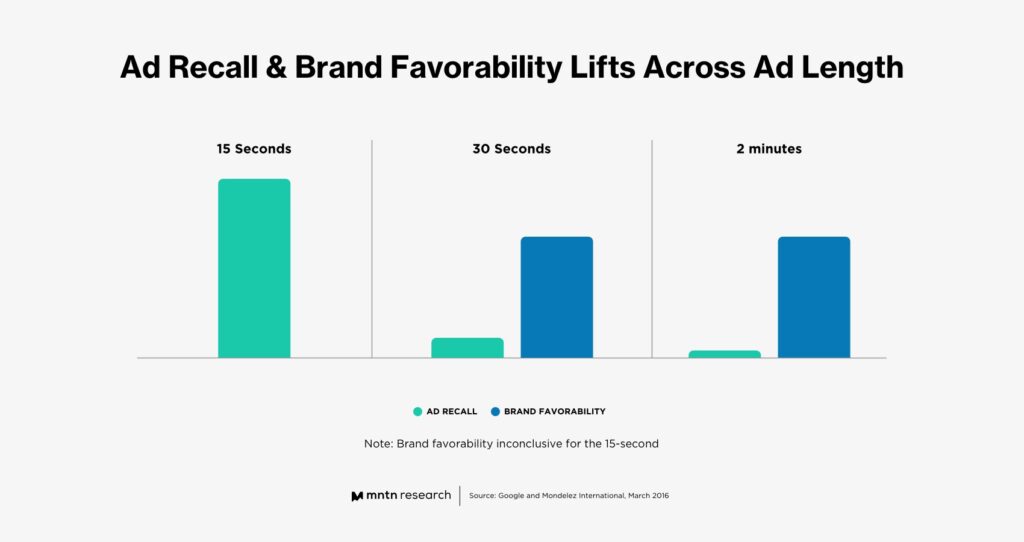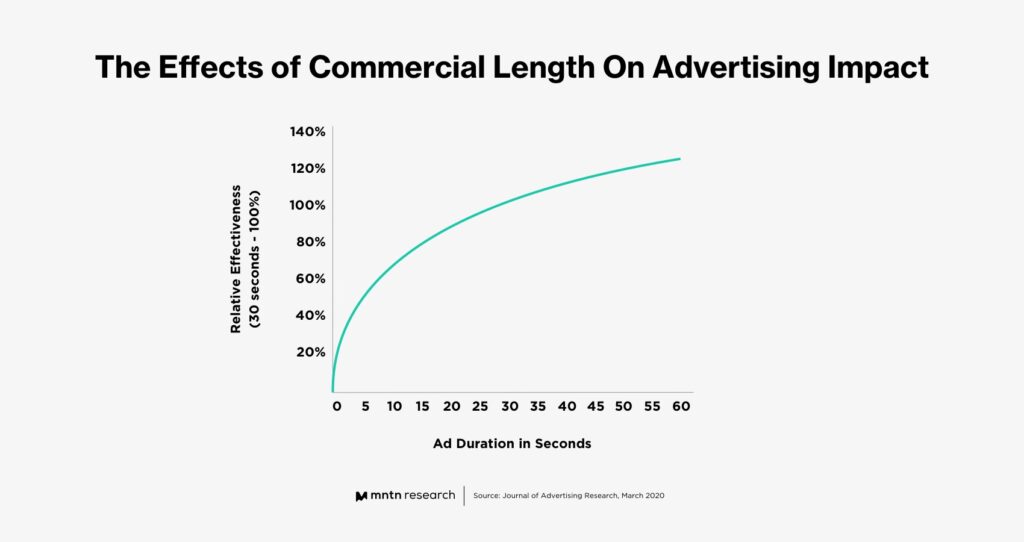Analysis
Shorter TV Ads Drive More Site Visits, But Longer Ads Fuel Conversions
by Melissa Yap4 min read
Abstract
- 15-second ads drive 46% higher site visits than 30-second ads.
- 30-second ads drive 24% higher conversions than 15-second ads.
- There is a correlation between commercial length and “diminishing returns”, however long ads deliver a stronger emotional connection with viewers.
Research shows that 15-second and 30-second ad spots influence performance differently, however the best performing ad length depends on campaign objectives.

Short Ads Have a Bigger Impact on Top-Funnel Metrics
QuickFrame by MNTN’s Video Vitals, a study which examined different ad elements’ impact on performance, analyzed over 1800 commercials scored across ad length, opening emotion, number of actors, industry verticals and more. It compared both visit rate and conversion rate across 15-second and 30-second ads, and concluded that the shorter ad length delivered 46% better performance than the 30-second ad (and 36% higher compared to the overall average visit rate).
Examining the psychological response to shorter ads can help us better understand this phenomenon. A study conducted by research firm MediaScience and the University of South Australia, coined this the “template theory of memory,” whereby most of the effect of advertisement length on advertisement awareness is delivered in the first five seconds of exposure. This study involved a sample size of 722 participants, with seven, 15-, 30- and 60-second variants of eleven ads tested across brand recall, ad favorability, brand attitude and biometrics. The research found that the seven-second ads were as effective as 15-second ads with ad recall as the measure of effectiveness.
Another study published by the Journal of Advertising Research further confirms this argument, where they compared 15- and 30-second ads and found that the former was 80% as effective in achieving recall and 90% as likeable as 30-second commercials. In fact, the seven-second ads delivered 60% of a 30-second ad’s brand recall. Finally, Google and Mondelez International, one of the world’s largest FMCG companies, conduct a brand lift study of YouTube’s 15-second, 30-second and 2-minute skippable ad format across three types of commercials. The 15-second ad drove the most ad recall across the three cuts.

Long Ads Help to Seal the Deal, But Beware the ‘Diminishing Returns’ Effects
While shorter ads are better at brand memorability and ad recall, they’re not as effective in encouraging viewers to take action. QuickFrame by MNTN’s Video Vitals report found that 30-second ads drove 24% higher conversions against the overall conversion rate when compared to 15-seconds ads. Longer ad lengths facilitate a more comprehensive narrative, as they allow more time to build a story, and they’re the ideal format to connect emotionally with viewers, and drive long-term memory. Since longer ads deliver more explicit brand information and have a more implicit effect on viewers than shorter ads, viewers are more likely to have a deeper connection and recall with the key messages and feelings toward the brand versus a shorter ad length.
Advertisers can take advantage of this longer format to communicate complex messages, like launching a new product or campaign, which ultimately helps to drive user action. The MediaScience and University of South Australia study, as referenced in the above section, also explored biometric indicators like smiling and skin conductance between long and short ads, and found that the former were better at taking viewers on an emotional journey with more ups and downs.
However, limitations exist where ad length is concerned. The Journal of Advertising Research explained the concept of “diminishing returns,” whereby ad effectiveness plateaus the longer the ad length, as shown in the chart below.

A way to mitigate this effect isn’t to go ‘all in’ on one type of ad length—diversification is key. Starting off with a longer, 30-second ad aims to first build positive brand associations with the viewer and establish neutral pathways (thereby establishing neural pathways between the brand and desired message/action), followed by shorter, ‘bite-sized’ content to reactivate that connection. A study by Thinkbox, the marketing body for commercial TV in the UK, screened long (60-second), medium (30-second) and short (10-, 6- or 5- second) ads to a sample size of 200 people. This research revealed that when a short ad was seen after a long ad, there was a 51% uplift in explicit memory effects versus just 9% for seeing a short ad in isolation.
Conclusion
Shorter ads deliver stronger ad recall and awareness, and prompts users to initiate search and discovery (such as site visits), however longer ad lengths build a deeper emotional connection with audiences and drive conversions. Ultimately, utilizing a combination of both longer and shorter ad lengths serves as a full-funnel strategy, however marketers should consider leading with the longer ad first to build positive brand associations with the viewer.
Subscribe to the MNTN Research Weekly
Sign up to receive a weekly feed of curated research, sent straight to your inbox.
Resources
1 Video Vitals analysis data (QuickFrame by MNTN)
2 In Video Advertising, is Longer Stronger? (Google and Mondelez International)
3 What Short Commercials Can and Can’t Deliver (Journal of Advertising Research)
4 Cost Per Second: The Relative Effectiveness of 15- and 30-Second Television Advertisements (University of South Australia)
5 A Matter of Time: The Importance of Time-Length in TV Advertising (Thinkbox TV)